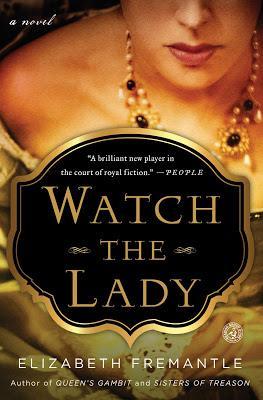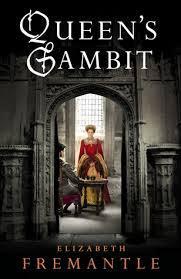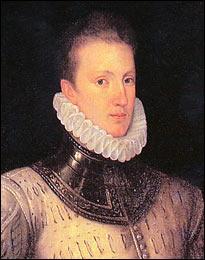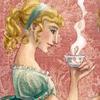 WATCH THE LADY is set in the Elizabethan Age. What is the allure of Tudor England on modern readers?
WATCH THE LADY is set in the Elizabethan Age. What is the allure of Tudor England on modern readers?It’s hard to say why the Tudor period has captivated modern readers so much more than other periods. I am personally fascinated by the state of political and cultural flux that came with the Reformation and the exploration of the New World, which coincided with an unprecedented half-century of female rule. England was late to the renaissance but in the late sixteenth century with writers such as Spenser, Sidney and Shakespeare there was a great literary flourishing that continues to have relevance today.
What is the most intriguing aspect of that age to you, instead, both as a historical researcher/writer and a reader?
My particular interest lies with women writers and this was the time when they began to take up their pens. My first book QUEEN’S GAMBIT is about Katherine Parr, the last wife of Henry VIII, who few know was one of the first women to publish an original work in the English language. The period is filled with intriguing and powerful women whose stories continue to captivate modern readers, some of which, like Penelope Devereux’s in WATCH THE LADY, have been forgotten by history and merit re-expooration.
Writing historical fiction must be challenging. How much do you work on research and how important is historical accuracy to you?
In my novels I like to remain faithful to the historical record but I am not under the illusion that it is possible to achieve absolute accuracy when dealing with the distant past. Often history contradicts itself, in differing points of view, and the truth remains elusive but there is usually a framework of known fact that I will work to.
What the fiction writer does, as opposed to the historian, is create a plausable inner world for their characters, which can only be an invention. A character’s intimate thoughts and feelings can be teased out from reading letters and looking at the way they might have responded to a set of circumstances but that is where the fiction lies. I find it important to immerse myself in knowledge about the world in which my characters lived, the social history, the way ordinary people passed their time, the details about everyday life, in order to create a believable back-drop to my stories. I glean information from all sorts of sources: Elizabethan etiquette manuals, letters, artefacts, architecture and portraits, as well as reading as many biographical works about all the people who populate my stories. But for me creating the environment is just as important as the facts of an individual’s life.
The heroine of your novel is Penelope Devereux, the woman who inspired Sir Philip Sidney love poetry. Is she a historical or a fictional character? Can you tell us more about her?
Penelope Devereux is very much a historical figure. She was the older sister of the Earl of Essex and belonged to one of the most prominent families in England. I was keen to tell her story because history has been unkind to her for the fact that she lived her life according to her own desires rather than being oppressed by the expected codes of female behavior in the period. James I dubbed her, ‘a fair woman with a black heart,’ and it was felt that her open adultery sullied the reputation of Sir Philip Sidney, who was held up as the appogee of Protestant chivalry. She was his muse, that is undeniable, but contemporary biographers saw his links to her as problematic and sought to distance him from such a controversial woman.Of course this is exactly what interests me about her.
Your Penelope reminds me of Shakespeare’s heroines, never actually damsels in distress (Portia, Viola, Celia) . What inspired you in depicting her personality?
As I mention above, it is Penelope’s refusal to behave obediently that I find fascinating. You’re right that women like her begin to appear in the work of Shakespeare and I suppose he was reflecting a social change. I read a good deal of the literature of the period for my research but it was the facts of Penelope’s life that truly inspired me.
 Robert Cecil and Queen Elizabeth are two historical characters in your novel. Is it challenging to give this iconic figure a voice ? And is it easier to write completely fictional characters or the historical ones? Why?
Robert Cecil and Queen Elizabeth are two historical characters in your novel. Is it challenging to give this iconic figure a voice ? And is it easier to write completely fictional characters or the historical ones? Why?The more famous a figure the more difficult I find they are to write, as one has to deal with so many preconceived notions. Henry VIII in QUEEN’S GAMBIT and Elizabeth I in SISTERS OF TREASON and WATCH THE LADYprovided the greatest challenges for this reason. It is hard to escape the idea of Henry as a great fat, one-dimensional tyrant. Depictions of Elizabeth are more varied. Elizabeth appears in all three of my Tudor novels and in a sense the trilogy is about her rise to power and the way she held onto it once she had it. That is the backdrop. She’s a fascinating and complex character but one who has been disected on countless occasions making it hard to be original. I wanted to show her contradictory nature: ruthless, yet vulnerable and hope I have succeeded. Robert Cecil on the other hand was a dream to write – he came to me fully formed as a character, perhaps because of his role as antagonist to the Devereuxs. He’s not a straightforward villain though and I wanted to expose the cracks in his armor.I rarely write purely fictional characters; even the insignificant people in my books were often the actual individuals who lived in close proximity to my characters. Jeanne, Penelope’s companion in WATCH THE LADY, for example was a real figure. In QUEEN’S GAMBIT Katherine Parr’s maid Dot was also a real figure though I expanded greatly on the very few facts known about her to make her a main character in the novel and in so doing turned her into a largely fictional figure. Giving a character a fictional narrative like this can help with the pacing of a narrative; when there is a lull in real events there is potential for action elsewhere.
 One of Philip Sidney’s most famous lines is “The only disadvantage of an honest heart is credulity”. What about his love for Penelope in your story?
One of Philip Sidney’s most famous lines is “The only disadvantage of an honest heart is credulity”. What about his love for Penelope in your story?I love this quote from Sidney; it seems to encapsulate his character. For my depiction of him and his love for Penelope I explored the sonnets – it’s all there, his affection, his jealous rages, his heartbreak. Astrophil and Stella is a staggeringly personal depiction of Sidney’s intimate feelings, so not much invention was needed on my part.
What is the trickiest, hardest aspect of writing historical fiction?
Sometimes it is a great challenge to make a true story work as fiction in terms of pacing and narrative arc. As I mentioned above, I seek to adhere to the historical record and sometimes this makes it hard to shape the story, but nothing is ever impossible.
When you are not writing, what do you like doing?
I’m a big reader and a great film buff, love visiting historic sites and when not at my desk I can usually be found walking my dogs.
I’m fond of reading historical fiction but I also love watching period drama series on TV? What do you think of costume drama series? Do you watch them? Would you like to see any of your books adapted?
I do love a costume drama and am very pleased to be able to say that QUEEN’S GAMBIT is being adapted for the screen, though it is likely to take some time to come to fruition.
What are you up to at present or in the next future?
I have just delivered a draft of my next book, which is about the tragic Arbella Stuart, a woman who was raised to be Elizabeth’s heir only to have her expectations thwarted when her cousin James I took the English throne. She was a complicated woman, who struggled to find a way to take control of her own destiny. Her story is intertwined with that of Elizabethan poet Aemilia Lanyer. This, as yet un-named novel, will be published in the UK next year and is the first in a quartet of Stuart books.
Thanks for being my guest at FLY HIGH!, Maria Elizabeth. Much appreciated. I can’t wait to read your novel!
It was a great pleasure. Thank you for having me.

Elizabeth Fremantle
Praise for Watch the LadyFrom “a brilliant new player in the court of royal fiction” (People) and the author of Queen’s Gambit and Sisters of Treason comes the mesmerizing story of Lady Penelope Devereux—the little-known, daring beauty in the Tudor court, who inspired Sir Philip Sidney’s famous sonnets even while she plotted against Queen Elizabeth.
Book Blurb
Penelope arrives at Queen Elizabeth’s court where she and her brother, the Earl of Essex, are drawn into the aging Queen’s favor. Penelope, though promised elsewhere, falls in love with Philip Sidney who pours his heartbreak into the now classic sonnet series, Astrophil and Stella. But Penelope is soon married off to a man who loathes her. Never a damsel in distress, she chooses her moment and strikes a deal with her husband: after she gives birth to two sons, she will be free to live as she chooses, with whom she chooses.
Meanwhile the devious politician, Robert Cecil, ever loyal to Elizabeth, has his eye on Penelope and her brother. Although it seems that Essex can do no wrong in the eyes of the Queen, as his influence grows, so his enemies gather. Penelope must draw on all her political savvy to save her brother from his own ballooning ambition and Cecil’s trap, while daring to plan for an event it is treason even to think about.
Smart, meticulously researched, thrilling and romantic, this book is a brilliant standout in its genre. If you love authors like Philippa Gregory, Hilary Mantel and Alison Weir, you must reads Maria Elizabeth Fremantle. In fact, The Bookseller called her first novel: “what Hilary Mantel fans should read while waiting for the final part of her trilogy.”
Discover more about Elizabeth Fremantle – Watch this video: A Day in the Life of Elizabeth Fremantle
Visit Elizabeth Fremantle's Official site

